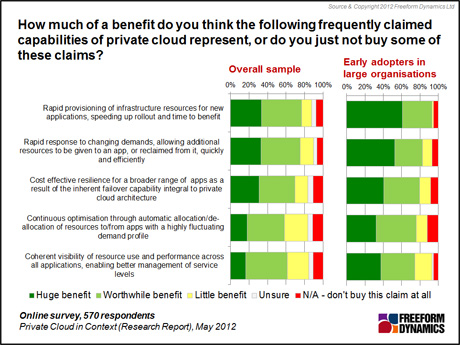Businesses are still operating under enormous economic pressure and, as would be expected, this continues to put CIOs on the spot when it comes time for budget setting. But whilst much of the IT press coverage attempts to paint a picture of budgets being decimated and CIOs being challenged to drastically cut costs, recent research undertaken by Freeform Dynamics indicates that reality is different (Figure 1). It is still possible for significant IT projects to be sanctioned.

Figure 1
The research further shows that IT is more likely to enjoy adequate funding in organisations where IT and its business have a good operational relationship based on trust and understanding. Perhaps even more importantly, IT budgets are much more likely to be well provisioned in organisations where IT is seen as being an integral part of business life. The challenge for a CIO is how to get non-technical senior managers comfortable so they understand how IT functions to support the objectives of the organisation. In many ways this comes down to improving communications channels, something that it can be easy to overlook for those looking after technology.
The experience of many organisations indicates that server virtualisation has been an area where IT and business as a whole have achieved considerable success. Importantly, it is also an area where significant benefits have been visibly allocated. So successful have projects in this area been that the majority of mid-sized enterprises and larger are already implementing x86 server virtualisation projects.
With many organisations now looking to virtualise other parts of the IT infrastructure, most notably storage and networking estates, to garner similar cost savings from better resource utilisation, the challenge for CIOs is increasingly shifting to how to get these other elements of the infrastructure managed effectively. It’s then a short step from this to looking at managing everything together more coherently, including servers, networking, storage and associated systems or platform software.
Against this background, many are now investigating so called. ‘Private Cloud’. However, ‘Private Cloud’ is a term that is currently being widely used and abused by vendors. As such it is necessary to provide an overall definition of the term in order to discuss things in non-technical language.
To this end we found that describing Private Cloud as ‘a means by which a number of servers and other resources (storage and networking) are pooled to create a general purpose platform upon which a variety of workload types can be run simultaneously’ was widely accepted by IT professionals. Private Cloud is a matter of interest to IT professionals, vendors, consultants and even business managers, as the benefits are well appreciated.

Figure 2
With awareness of private cloud as a logical step forwards from the systems virtualisation projects already underway, our survey reported some interesting differences in perception between early adopters and those yet to begin. In particular it is clear, as shown in Figure 2, that many of the capabilities and benefits achievable from implementing private cloud systems, most notably around the ability to provision new services and react rapidly to changing conditions, may be underestimated by those yet to start down the road.
But there are also challenges that need to be addressed before private cloud solutions can become anything like the normal way of delivering IT services. And some of these are not ‘technical’ problems. Whilst many organisations are comfortable with the traditional project financing approach common today to fund IT, this model can be awkward when applied to building and running IT services using a shared resources infrastructure.
So while moving towards a private cloud model to deliver IT services offers many advantages in terms of flexibility, speed of service delivery and cost control, it begs the question, ‘are you ready to ask your peers to change the way IT is paid for?’ With Private Clouds on many horizons, the time to prepare is approaching and it is well known that while changing IT systems can be complex, this is nothing compared to getting business, especially finance departments, to alter the way their calculations are based.
The introduction of flexible IT may well require the introduction of flexible IT financing, something with which there is today little experience. The alternative will be to fund a core IT infrastructure and work out ways in which resource allocation can be based on business needs rather than simply who paid for a piece of software and its associated hardware. It’s that or “Chargeback”, and the indications are that few organisations are ready to face that challenge.
CLICK HERE TO VIEW ORIGINAL PUBLISHED ON

Tony is an IT operations guru. As an ex-IT manager with an insatiable thirst for knowledge, his extensive vendor briefing agenda makes him one of the most well informed analysts in the industry, particularly on the diversity of solutions and approaches available to tackle key operational requirements. If you are a vendor talking about a new offering, be very careful about describing it to Tony as ‘unique’, because if it isn’t, he’ll probably know.





Have You Read This?
From Barcode Scanning to Smart Data Capture
Beyond the Barcode: Smart Data Capture
The Evolving Role of Converged Infrastructure in Modern IT
Evaluating the Potential of Hyper-Converged Storage
Kubernetes as an enterprise multi-cloud enabler
A CX perspective on the Contact Centre
Automation of SAP Master Data Management
Tackling the software skills crunch